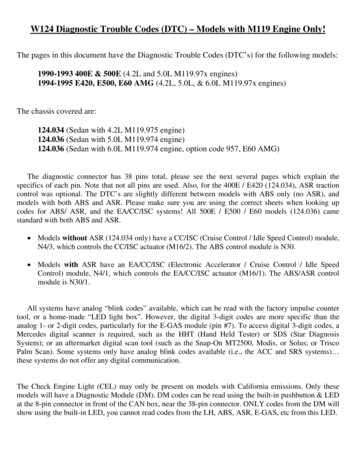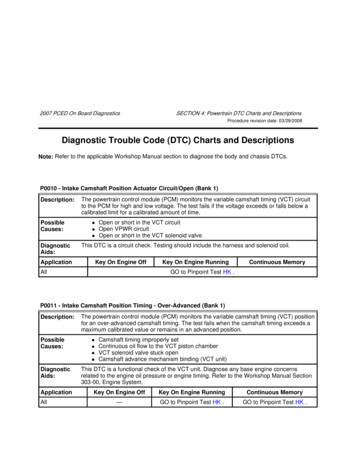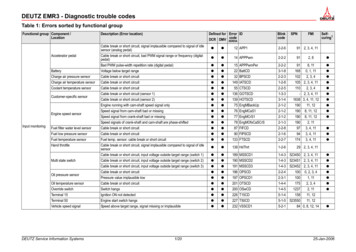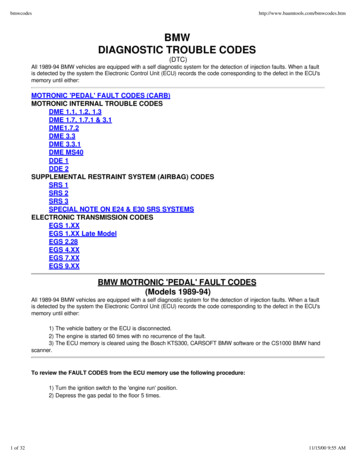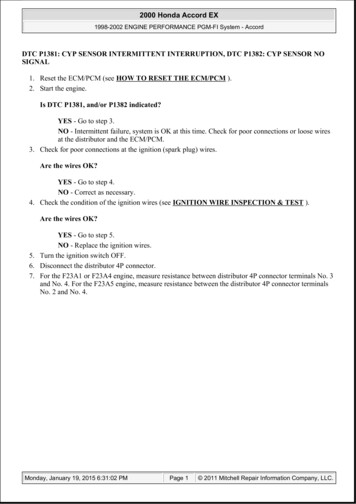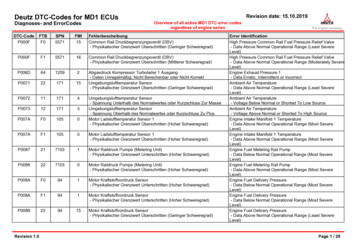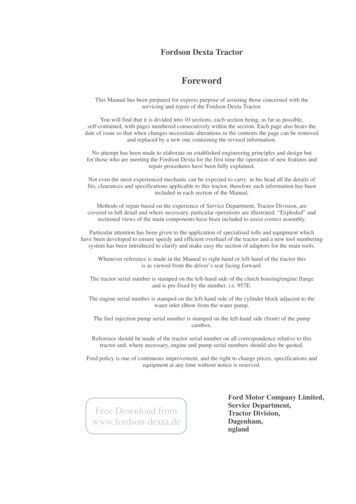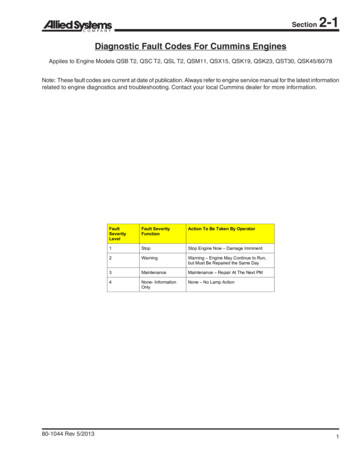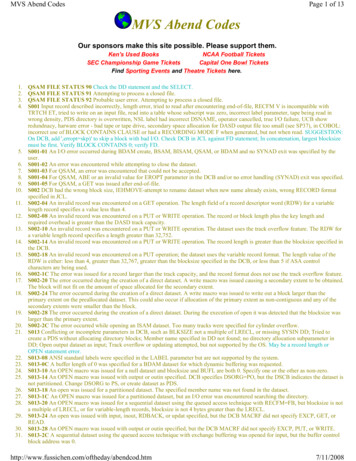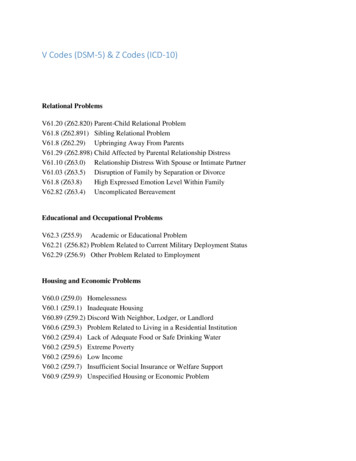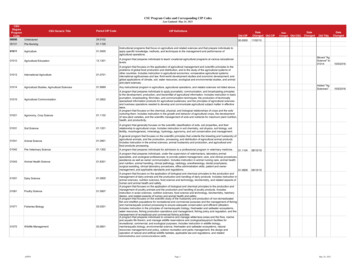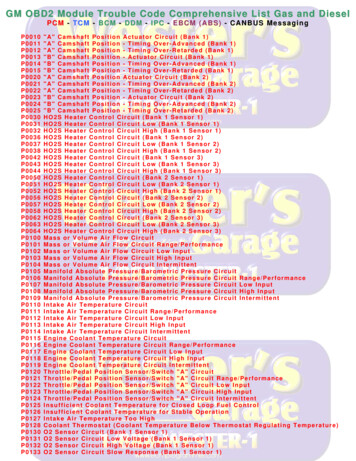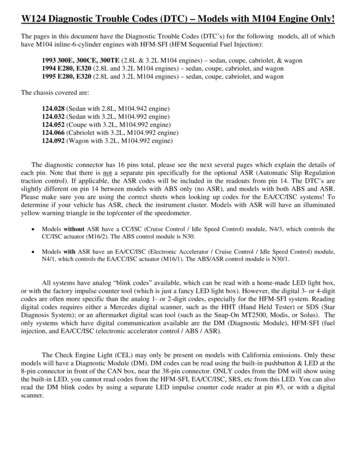
Transcription
W124 Diagnostic Trouble Codes (DTC) – Models with M104 Engine Only!The pages in this document have the Diagnostic Trouble Codes (DTC’s) for the following models, all of whichhave M104 inline-6-cylinder engines with HFM-SFI (HFM Sequential Fuel Injection):1993 300E, 300CE, 300TE (2.8L & 3.2L M104 engines) – sedan, coupe, cabriolet, & wagon1994 E280, E320 (2.8L and 3.2L M104 engines) – sedan, coupe, cabriolet, and wagon1995 E280, E320 (2.8L and 3.2L M104 engines) – sedan, coupe, cabriolet, and wagonThe chassis covered are:124.028 (Sedan with 2.8L, M104.942 engine)124.032 (Sedan with 3.2L, M104.992 engine)124.052 (Coupe with 3.2L, M104.992 engine)124.066 (Cabriolet with 3.2L, M104.992 engine)124.092 (Wagon with 3.2L, M104.992 engine)The diagnostic connector has 16 pins total, please see the next several pages which explain the details ofeach pin. Note that there is not a separate pin specifically for the optional ASR (Automatic Slip Regulationtraction control). If applicable, the ASR codes will be included in the readouts from pin 14. The DTC’s areslightly different on pin 14 between models with ABS only (no ASR), and models with both ABS and ASR.Please make sure you are using the correct sheets when looking up codes for the EA/CC/ISC systems! Todetermine if your vehicle has ASR, check the instrument cluster. Models with ASR will have an illuminatedyellow warning triangle in the top/center of the speedometer. Models without ASR have a CC/ISC (Cruise Control / Idle Speed Control) module, N4/3, which controls theCC/ISC actuator (M16/2). The ABS control module is N30. Models with ASR have an EA/CC/ISC (Electronic Accelerator / Cruise Control / Idle Speed Control) module,N4/1, which controls the EA/CC/ISC actuator (M16/1). The ABS/ASR control module is N30/1.All systems have analog “blink codes” available, which can be read with a home-made LED light box,or with the factory impulse counter tool (which is just a fancy LED light box). However, the digital 3- or 4-digitcodes are often more specific than the analog 1- or 2-digit codes, especially for the HFM-SFI system. Readingdigital codes requires either a Mercedes digital scanner, such as the HHT (Hand Held Tester) or SDS (StarDiagnosis System); or an aftermarket digital scan tool (such as the Snap-On MT2500, Modis, or Solus). Theonly systems which have digital communication available are the DM (Diagnostic Module), HFM-SFI (fuelinjection, and EA/CC/ISC (electronic accelerator control / ABS / ASR).The Check Engine Light (CEL) may only be present on models with California emissions. Only thesemodels will have a Diagnostic Module (DM). DM codes can be read using the built-in pushbutton & LED at the8-pin connector in front of the CAN box, near the 38-pin connector. ONLY codes from the DM will show usingthe built-in LED, you cannot read codes from the HFM-SFI, EA/CC/ISC, SRS, etc from this LED. You can alsoread the DM blink codes by using a separate LED impulse counter code reader at pin #3, or with a digitalscanner.
This document includes the complete list of DTC’s for the following systems:Pin #3 - Diagnostic Module (May only be present on models with California emissions)(WIS Group 07.51, subgroup 8.4, section 11, one page)Pin #6 - Airbag / SRS (Supplemental Restraint System)(WIS Group 91.60, subgroup 16.1, section 12, one page) - Only blink codes are availablePin #7 - ACC (Automatic Climate Control)(WIS Group 83.30, subgroup 0503, section B, four pages) - Only blink codes are availablePin #8 - HFM-SFI Fuel Injection & Digital Ignition System(WIS Group 07.51, subgroup 1.1, section 11, seven pages)Pin #9 - Roll Bar (Cabriolet only)(WIS Group 91.59, subgroup 19.1, section 12, one page) - Only blink codes are availablePin #14 - CC/ISC (Cruise Control / Idle Speed Control) – For models without ASR traction control(WIS Group 30.21, subgroup 7.3, section 11, two pages)Pin #14 - EA/CC/ISC (Electronic Accelerator / CC / ISC) – For models with ASR traction control(WIS Group 30.20, subgroup 6.4, section 11, two pages)CST / RB (Cabriolet Soft Top / Roll Bar) – Not tested at 16-pin connector – see diagram(WIS Group 77.39, subgroup 11.1, section 12, two pages) - Only blink codes are available
Note: Circuit 15 is 12VDC, Ignition Switched
Diagnosis - Diagnostic Trouble Code (DTC) MemoryPreparation for recalling diagnostic trouble code (DTC) memory1. Connect impulse counter scan tool and adaptor for impulse counter totest connection for diagnosis (X11/4) according to connection diagram(see section 0).Note:Connect impulse counter scan tool as follows:red wire to socket 16,black wire to socket 1 andyellow wire to:Diagnostic moduleEngine control moduleEA/CC/ISC control modulesocketsocketsocket38142. Recall control modules' diagnostic trouble code memory and clear storedtrouble codes (see section 0).NoteThe retained diagnostic trouble code (DTC) memory feature of thediagnostic module has been replaced with DTC memory which is clearedafter disconnecting the vehicle's battery (DM voltage supply).In addition, the DTC readout 1" (no malfunction in system) does notappear after clearing the DTC memory (disconnecting the vehicle'sbattery). DTC readout 1" only reappears during the vehicle'ssubsequent trip after the diagnostic module has confirmed that allmonitored systems and their respective components are ok(no malfunctions).Special ToolsDM - Diagnostic Module(Pin #3)Diagnosis - Diagnostic Trouble Code (DTC) MemoryDiagnostic Trouble Code (DTC) Readout, Diagnostic ModuleDiagnostic TroubleCode (DTC)1)Possible CauseRemedy/Test Step1)12No malfunction in systems monitored-Heated oxygen sensor inoperativeTest HFM-SFI, Engines Vol.2, section 1.34Lambda control inoperativeTest HFM-SFI, Engines Vol.2, section 1.Air injection inoperativeTest HFM-SFI, Engines Vol.2, section 1.56Exhaust gas recirculation inoperativeTest HFM-SFI, Engines Vol.2, section 1.Idle speed control inoperativeTest EA/CC/ISC, sections 6/7.78Ignition system defectiveTest HFM-SFI, Engines Vol.2, section 1.Engine coolant temperature sensor, open/short circuitTest HFM-SFI, Engines Vol.2, section 1.910Intake air temperature sensor, open/short circuitTest HFM-SFI, Engines Vol.2, section 1.Voltage at hot wire mass air flow sensor too high/lowTest HFM-SFI, Engines Vol.2, section 1.1112TN-signal (rpm) at engine control module (N3/4) defectiveTest HFM-SFI, Engines Vol.2, section 1.Heated oxygen sensor heater, open/short circuitTest HFM-SFI, Engines Vol.2, section 1.15Wide open throttle information defectiveTest EA/CC/ISC, sections 6/7.Observe Preparation for Test, see22.Diagnosis - Diagnostic Trouble Code (DTC) MemoryDiagnostic TroubleCode (DTC)1)1)Possible CauseRemedy/Test Step16Closed throttle position information defectiveTest EA/CC/ISC, section 6/7.1718Data exchange malfunction between individual control modulesAdjustable camshaft timing solenoid, open/short circuitTest HFM-SFI, Engines, Vol. 2, section 119Fuel injectors open/short circuit orself-adaptation in engine control module (N3/4) at limitTest HFM-SFI and reset engine control module adaptationto mean value, Engines, Vol. 2, section 12021Speed signal not presentTest HFM-SFI, Engines, Vol. 2, section 1Purge switchover valve, open/short circuitTest HFM-SFI, Engines, Vol. 2, section 12223Camshaft position sensor signal defectiveTest HFM-SFI, Engines, Vol. 2, section 123Intake manifold pressure (in base module pressure sensor- B5/2) with enginerunning too low/high236.0.7.0.24Starter ring gear segments and/or crankshaft position sensor defectiveTest HFM-SFI, Engines, Vol. 2, section 12526Knock sensors or engine control module defectiveTest HFM-SFI, Engines, Vol. 2, section 1Upshift delay defectiveTest HFM-SFI, Engines, Vol. 2, section 12728Not used-Engine coolant temperature sensor (coolant temperature change monitor)Test HFM-SFI, Engines, Vol. 2, section 1Observe Preparation for Test, see22.Copyright Daimler AG 11/4/08 G/06/08. This WIS printout will not be recorded by the update service.Page 1
Diagnosis - Diagnostic Trouble Code (DTC) Memory (driver-side or driver/passenger-side airbag)Preliminary work:Diagnosis - Function TestSRS - Airbag(Pin #6)11Preparation for DTC readoutFuses O.K.Connect impulse counter scan tool to data link connector (X11/4) according toconnection diagram (see section 0).8 or 16-pole connector:yellow wire to socket 638-pole connector:yellow wire to socket 30The 10-pole SRS test connection (X11/13) must be connected for DTC.Special Tools124 589 19 21 00140 589 14 63 00Pulse counterAdapterDiagnosis - Diagnostic Trouble Code (DTC) Memory (driver-side or driver/passenger-side airbag)Diagnostic troublecode (DTC)2)1)2)Possible causeTest step/Remedy 1)No fault recognized in system-SRS control module (N2/2)232.0Driver airbag squib (R12/3)233.0, 9.0Front passenger airbag squibs (R12/4, R12/5)234.0, 10.0Left front seat belt buckle switch (S68/3)235.0Right front seat belt buckle switch (S68/4)236.0Front passenger airbag resistance237.0Voltage supply circuit 15R231.0SRS malfunction indicator lamp (A1e15) or time limit for DTC readout /erasingexceededSRS control module (N2/2)238.0N2/2 (SMS, Job No. 91-620)Observe Preparation for Test, see22.DTCindicates that the airbag deployment stage was activated in the control module. This DTC can not be erased.IMPORTANT NOTE!Before replacing the SRS control module (N2/2) in cases of DTCconnection.Note:The ETR's are not included in the DTC readout, if DTCand/orThe control module must be replaced.without an airbag deployment, reposition airbag harness ground connections to lowest terminalcan not be erased, see ETR TestCopyright Daimler AG 11/4/08 G/06/08. This WIS printout will not be recorded by the update service.321.0 and 2.01).Page 1
ACCAutomatic Climate Control(Pin #7)
ACCAutomatic Climate Control(Pin #7)
ACCAutomatic Climate Control(Pin #7)
ACCAutomatic Climate Control(Pin #7)
Diagnosis - Diagnostic Trouble Code (DTC) MemoryPreliminary work:Engine Test, Adjustment, Engines, Volume 1Note regarding diagnostic trouble code (DTC) readout:The engine control module (N3/4) for the HFM-SFI system is equipped withdiagnostic trouble code (DTC) memory. Malfunctions are recognized andstored as trouble codes and are distinguished as follows:Malfunctions which are constantly present,Malfunctions which occur longer than 3 seconds,Intermittent contact malfunctions which have occured 5during a trip.The DTC memory remains active even if the vehicle's battery is disconnected.Malfunctions which are no longer present, are automatically erased againafter a maximum of 19 trips. A trip has occured if:Vehicle speed 4 km/h (2.5 mph),Engine speed 700 rpm,Engine shut off for 30 seconds.The stored diagnostic trouble codes (DTCs) can be read at the data linkconnector (X11/4) with the ignition switched ON or with the enginerunning .HFM Fuel Injection(Pin #8)Note regarding mixture preparation self-adaptation:The Lambda control system determines fuel injection duration precisely sothat the fuel/air ratio is kept constant at Lambda level 1 (equals 14.7 kg air to1 kg fuel) under all operating conditions.Should malfunctions occur in the form of:Intake air leaks,Injector wear or carbon build-up,Engine wear,Contact resistance in MAF sensor,Defective diaphragm pressure regulator,Defective purge control valve,the engine control module automatically performs a mixture adjustment. Thedegree of correction is calculated constantly and stored permanently. Theself-adaptation is performed at idle and under partial load. Maximumcorrection towards rich or lean is 25%. After repair work is performed, theengine control module will automatically adapt itself again after approx. 10trips. After eliminating a malfunction or after trial installation of an enginecontrol module from another vehicle, the self-adaptation feature must be resetto its mean value (see Resetting and Reactivating Engine Control ModuleMemory"11/5).Diagnosis via an on-off ratio readout has been eliminated.Diagnosis - Diagnostic Trouble Code (DTC) MemoryNote regarding automatic recognition of vehicle equipment and/orversion on vehicles up to 02/94 (up to HHT Diagnosis Version 42):The engine control module recognizes and stores the following equipmentand/or version information during the vehicle's initial operation:Catalytic converter/non-cataytic converter,Manual/automatic transmission,4-Speed/5-speed automatic transmission,Cruise control,Electronic accelerator,version.After replacing the engine control module or after trial installation of an enginecontrol module from another vehicle, the stored data must be erased and therecognition feature reactivated (see Resetting and Reactivating EngineControl Module Memory"11/5).Initial programming of engine control module.Note regarding version coding on vehicles as of 03/94 (as of HHTDiagnosis Version 45):The engine control module is equipped with a version coding feature as of03/94. The coding must be performed with the Hand-Held Tester(automatically or manually, see Notes for HHT11/4) upon installation of anew control module.The following vehicle version data must be determined for coding:Vehicle model,Catalytic converter (TWC),Non-catalytic converter (non-TWC),5-speed manual transmission,4-speed automatic transmission,5-speed automatic transmission,Cruise control (CC),Acceleration slip regulation (ASR),Electronic traction system (ETS),Country version.Prerequisite for initial programming process:Battery voltage11 Volt minimumVehicle speed signalV 0Engine rpm signaln 0Transmission rangeP/N 1Idle speed contact closedCTP 1(Caution: Vehicle can not be moved during initial programming process)Drive vehicleV 5 km/h (3 mph)(Only then will the transmission version be recognized).Diagnosis - Diagnostic Trouble Code (DTC) MemoryCopyright Daimler AG 11/4/08 G/06/08. This WIS printout will not be recorded by the update service.Page 1
Note regarding drive authorization system (DAS):Additionally, the code number and VIN must be entered (see HHT ac
W124 Diagnostic Trouble Codes (DTC) – Models with M104 Engine Only! The pages in this document have the Diagnostic Trouble Codes (DTC’s) for the following models, all of which have M104 inline-6-cylinder engines with HFM-SFI (HFM Sequential Fuel Injection): 1993 300E, 300CE, 300TE (2.8L & 3.2L M104 engines) – sedan, coupe, cabriolet, & wagonFile Size: 792KBPage Count: 23
